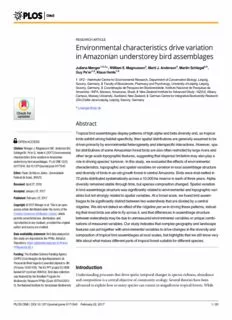Table Of ContentRESEARCHARTICLE
Environmental characteristics drive variation
in Amazonian understorey bird assemblages
JulianaMenger1,2,3*,WilliamE.Magnusson3,MartiJ.Anderson4,MartinSchlegel2,5,
GuyPe’er1,5,KlausHenle1,5
1 UFZ–HelmholtzCentreforEnvironmentalResearch,DepartmentofConservationBiology,Leipzig,
Saxony,Germany,2 FacultyofBiosciences,PharmacyandPsychology,UniversityofLeipzig,Leipzig,
Saxony,Germany,3 Coordenac¸ãodePesquisaemBiodiversidade,InstitutoNacionaldePesquisasda
Amazoˆnia-INPA,Manaus,Amazonas,Brazil,4 NewZealandInstituteforAdvancedStudy-NZIAS,Albany
Campus,MasseyUniversity,Auckland,NewZealand,5 GermanCentreforIntegrativeBiodiversityResearch
a1111111111 (iDiv)Halle-Jena-Leipzig,Leipzig,Saxony,Germany
a1111111111
a1111111111 *[email protected]
a1111111111
a1111111111
Abstract
Tropicalbirdassemblagesdisplaypatternsofhighalphaandbetadiversityand,astropical
birdsexhibitstronghabitatspecificity,theirspatialdistributionsaregenerallyassumedtobe
OPENACCESS
drivenprimarilybyenvironmentalheterogeneityandinterspecificinteractions.However,spa-
Citation:MengerJ,MagnussonWE,AndersonMJ,
tialdistributionsofsomeAmazonianforestbirdsarealsooftenrestrictedbylargeriversand
SchlegelM,Pe’erG,HenleK(2017)Environmental
otherlarge-scaletopographicfeatures,suggestingthatdispersallimitationmayalsoplaya
characteristicsdrivevariationinAmazonian
understoreybirdassemblages.PLoSONE12(2): roleindrivingspecies’turnover.Inthisstudy,weevaluatedtheeffectsofenvironmental
e0171540.doi:10.1371/journal.pone.0171540 characteristics,topographicandspatialvariablesonvariationinlocalassemblagestructure
Editor:PauloDeMarcoJu´nior,Universidade anddiversityofbirdsinanold-growthforestincentralAmazonia.Birdsweremist-nettedin
FederaldeGoias,BRAZIL 72plotsdistributedsystematicallyacrossa10,000hareserveineachofthreeyears.Alpha
Received:April27,2016 diversityremainedstablethroughtime,butspeciescompositionchanged.Spatialvariation
inbird-assemblagestructurewassignificantlyrelatedtoenvironmentalandtopographicvari-
Accepted:January22,2017
ablesbutnotstronglyrelatedtospatialvariables.Atabroadscale,wefoundbirdassem-
Published:February22,2017
blagestobesignificantlydistinctbetweentwowatershedsthataredividedbyacentral
Copyright:©2017Mengeretal.Thisisanopen
ridgeline.Wedidnotdetectaneffectoftheridgelineperseindrivingthesepatterns,indicat-
accessarticledistributedunderthetermsofthe
ingthatmostbirdsareabletoflyacrossit,andthatdifferencesinassemblagestructure
CreativeCommonsAttributionLicense,which
permitsunrestricteduse,distribution,and betweenwatershedsmaybeduetounmeasuredenvironmentalvariablesoruniquecombi-
reproductioninanymedium,providedtheoriginal nationsofmeasuredvariables.Ourstudyindicatesthatcomplexgeographyandlandscape
authorandsourcearecredited.
featurescanacttogetherwithenvironmentalvariablestodrivechangesinthediversityand
Dataavailabilitystatement:Birddataanalyzedin compositionoftropicalbirdassemblagesatlocalscales,buthighlightsthatwestillknowvery
thisstudyaredepositedinthePPBio,MetaCat
littleaboutwhatmakesdifferentpartsoftropicalforestsuitablefordifferentspecies.
Repository:https://ppbiodata.inpa.gov.br/#view/
PPBioAmOc.82.4.
Funding:TheBrazilianScienceFundingAgency
CAPES(Coordenac¸ãodeAperfeic¸oamentode
PessoaldeN´ıvelSuperior)awardedstipendtoJM
(Process12401129).TheEUFP7projectEUBON Introduction
fundedGP(contract308454).Bird-datacollection
Understandingprocessesthatdrivespatio-temporalchangesinspeciesrichness,abundance
wasfinancedbytheBrazilianProgramfor
andcompositionisacentralobjectiveofcommunityecology.Severaltheorieshavebeen
BiodiversityResearchPPBio(Grant457544/2012-
0),theNationalInstituteforAmazonianBiodiversity advancedtoexplainhowsomanyspeciescancoexistinmegadiversetropicalforests.While
PLOSONE|DOI:10.1371/journal.pone.0171540 February22,2017 1/20
EnvironmentdrivesAmazonianunderstoreybirdassemblages
INCT-CENBAM(Grant573721/2008-4)andthe nichetheorysuggeststhatspecies’distributionsaredrivenbyenvironmentalheterogeneity
BrazilianLong-TermEcologicalResearchProject andspecies’interactions[1–4],neutraltheorypositsthatspecies’distributionsariselargely
PELD(Grant403764/2012-2)throughtheBrazilian
fromrandomprocesses,withlocalassemblagecompositionbeingdeterminedmainlybysto-
NationalResearchCouncilCNPq.Thefundershad
chasticprocessesanddispersallimitation[5].Empiricalstudiesattemptingtodisentanglethe
noroleinstudydesign,datacollectionand
relevanceofnichevs.neutralprocessesinshapingthecompositionoftropicalassemblages
analysis,decisiontopublish,orpreparationofthe
manuscript. haveshowncomplementaryeffectsofenvironmentalfactorsanddispersallimitation[6–12],
withtheirrelativeimportanceoftendependingonthespatialscaleofthestudy.
Competinginterests:Theauthorshavedeclared
Manypreviousstudieshaveusedgeographicaldistanceasaproxyfordispersallimitation,
thatnocompetinginterestsexist.
withoutexplicitlymodelingpotentialeffectsofphysicallandscapefeaturesthatmayactasbar-
rierstospecies’movement[9].Forinstance,inlowlandAmazonia,largerivershavebeeniden-
tifiedasbarrierstodispersalofseveralvertebratespecies[13].Atlargescales,some
Amazonianforestbirdshavedistributionsrestrictedtodistinctareasofendemism,delimited
primarilybythemajorAmazonianrivers[14–19].Atfinerscales,thereisgrowingevidence
thatAmazonianforestbirdshaverestricteddispersal[20–23].Locallandscapefeatures,such
asmosaicsofinhospitableareasandevennarrowroadsthroughaforest,mayactasbarriers,
limitingbirdterritoriesandmovements[24–26].
Nonetheless,withinaninterfluve,variationinAmazonianforestbirdcommunitiesisusu-
allyassumedtobedrivenprimarilybyenvironmentalheterogeneityandinterspecificinterac-
tions,ratherthanbydispersallimitation[4,27].Indeed,mostAmazonianforestbirdsare
thoughttobehabitatspecialists,andtheirspatialpatternsofdiversityandcompositionare
affectedbyenvironmentalfactors,suchasvegetationstructure,floristiccompositionand
topography[28–34].Althoughtheroleofdispersaltraitsinstructuringavianassemblagesin
fragmentedlandscapeshasbeeninvestigated[35],fewstudieshavesimultaneouslyinvesti-
gatedtheeffectsofenvironmentalcharacteristicsanddispersallimitationonAmazonianbird-
assemblagesinnaturallyheterogeneouslandscapes(butsee[9,31]).
Here,weinvestigatetheeffectsofenvironmentalcharacteristics,landscapefeaturesandspa-
tialvariablesonvariationinthediversityandstructureofbirdassemblagesina10,000ha
reserveincentralAmazonia,Brazil.WesampledunderstoreybirdsintheDuckeForest
Reserve(DFR,Fig1),whichiscoveredbylargelyundisturbedold-growthforest.Althoughthe
urbansprawlofthecityofManaushasreachedthesouthernandwesternlimitsofDFR,the
reserveisstillconnectedtocontinuousforestonitseasternsideanddoesnotshowanyobvi-
ousimpactsofurbanizationwithinitslimits.Smallstreamsareabundantinthearea,resulting
inanundulatingterrainwithridgesupto140mabovesealevel(a.s.l.),interspersedbyvalleys
thatmaybeaslowas40ma.s.l.,yieldinghighenvironmentalvariation[36].Moreover,the
reserveistraversedbyacentralridgewhichrunsfromnorthtosouth,dividingDFRintotwo
majorwatersheds:thewesternwatersheddrainstotributariesoftheNegroRiver(blackwater),
whiletheeasternwatersheddrainstotributariesoftheAmazonRiver(whitewater).Thespa-
tialconfigurationofDFRprovidesanexcellenttest-bedfortheevaluationofenvironmental,
topographicandspatialfactorsaffectingforest-birdassemblagestructureatalocalscale.
Despiteitssmallelevationalrange,wehypothesizedthatthecentralridgelinereducesbird
movementsacrosswatersheds,contributingtodistinctbirdassemblagesineachwatershed.
Weinvestigatedspatiotemporalvariationindiversityandassemblagestructureandquantified
theextenttowhichenvironmental,topographicandspatialvariablesexplainthesepatterns.
Methods
Ethicsstatement
FieldworkwascarriedoutwithauthorizationandapprovaloftheBrazilianBiodiversity
AuthorizationandInformationSystem—SISBIO(Permit34850)andoftheBrazilianCenter
PLOSONE|DOI:10.1371/journal.pone.0171540 February22,2017 2/20
EnvironmentdrivesAmazonianunderstoreybirdassemblages
Fig1.LocationofDuckeForestReserve(DFR),Manaus,AmazonasState,Brazil.LocationofDFRinrelationtothecityofManausandtothe
mainrivers(a);Topography,streamsandthesystemoftrails(dashedlines)inthestudyarea,showingthe72samplingplots(b).Thebrownline
marksthedivisionofthereserveintoeastern(n=34)andwestern(n=38)watersheds.Thecolorsoftheplotsindicatethethreeenvironmentalgroups
identifiedbyK-meanspartitioning.BeigedotsrepresentLowareas(n=20),palegreendotsrepresentHighareas(n=31),anddarkgreendots
representSlopeareas(n=21).
doi:10.1371/journal.pone.0171540.g001
forBirdBandingandConservation—CEMAVE(Permit3576).Theselicensescoveredallnec-
essaryanimalethics,includingapermittocapturebirds,andappropriatemethodsforhan-
dlingandbandingthebirds,inaccordancewiththeenvironmentallegislationofBrazil
(Instruc¸ãoNormativaIBAMAN˚27/2002andInstruc¸ãoNormativaICMBioN˚154/2007);
followingprotocolsestablishedbyCEMAVE[37].Weaffirmfieldworkdidnotinvolveendan-
geredorprotectedspecies.
Studysite
TheDuckeForestReserve(02˚55’–03˚01’S,59˚53’–59˚59’W),locatedontheoutskirtsof
Manauscity,Amazonasstate,Brazil(Fig1a),iscoveredbyterrafirmeforeststhatarenot
subjecttolong-termfloods[36].Theunderstoreyisdominatedbyacaulescentpalmsand
shadedbyaclosedcanopy.Soiltypevariesalonganelevationgradient;soilswithhigherclay
contentoccurathigherelevationandsandiersoilsoccuratlowerelevation[38].Themean
annualtemperatureandprecipitationfrom1979to2008were26˚Cand2524mm,respec-
tively[39].ArainyseasontypicallyoccursfromNovembertoJuneandadryseasonfrom
JulytoOctober[36].
DFRisasiteintheBrazilianLongTermEcologicalResearch(LTER)networkandhasasys-
tematicsamplinggridthatispartoftheBrazilianBiodiversityResearchProgram(PPBio,
PLOSONE|DOI:10.1371/journal.pone.0171540 February22,2017 3/20
EnvironmentdrivesAmazonianunderstoreybirdassemblages
https://ppbio.inpa.gov.br).Thegridgivesaccessto72permanentplotsplacedsystematicallyat
1-kmintervalsalongnineeast-westtrails(Fig1b).Eachplotis250minlengthandfollows
topographiccontourlinestoavoidwithin-plotedaphicvariation[40,41].
Birdsampling
Wesampledbirdsinall72plotsoftheDFRduringthedryseasonineachofthreeconsecutive
years(2012–2014).Toavoidbiasesincaptureratesduetonetavoidance[42],eachplotwas
sampledonasingledayduringeachsamplingperiod.Sixteenmist-nets(each9mlong,32
mmmeshsize)weresetinpairsat10-mintervalsalongthe250mlengthofeachplot[43].
Mist-netswereopenedbetween06:00and12:00andinspectedevery40min.Birdscaptured
wereidentifiedandbandedwithmetalbandsissuedbyCEMAVE.Thetotalabundanceof
eachspeciescapturedineachnettingeventwasaggregatedperplot.Mist-nettingisawidely
usedtechniquetosampleunderstoreybirds,asitdetectsmorecryptic,ground-foragingand
non-singingbirdsthanauralorvisualsurveys[28].However,itisalsoknowntounder-sample
specieswhichusuallyflyabovenetlevel,andonlyoccasionallydescendtotheground[32].To
evaluatewhetherunder-samplingmightinfluencetheresults,weanalyzedthedataintwosep-
aratesets:1)“allspecies”(98spp,seeResults)–whichincludedallspeciescapturedand;2)
“commonforestunderstoreyspecies”(63spp)–whichincludedonlyspeciescapturedinmore
thantwoplots,thatusepredominantlythelowerlayersoftheforest,anduseprimarilyterra
firmeforests(following[44]).BirddataanalyzedinthisstudyaredepositedinthePPBio,
MetaCatRepository:https://ppbiodata.inpa.gov.br/#view/PPBioAmOc.82.4[45].
Identificationofenvironmentalgroups
Dataonelevation,slope,clayandsiltcontentofthesoil,treeandpalmdensity,distancetothe
neareststreamandgeographicalcoordinates(latitudeandlongitude)foreachplotwereused
asexplanatoryvariables(S1Table,assharedonthePPBiowebsite).Elevation,slope,distance
totheneareststream,clayandsiltcontentofthesoil,treeandpalmdensitywerenormalized
toz-scores,andK-meanspartitioning[46,47]wasusedtoidentifygroupsofplotsbasedon
theseenvironmentalvariables.Wedeterminedthenumberofgroupsbyconsideringthepat-
ternofdecreaseinthewithin-groupsumofsquareddistancestocentroidswithincreasing
numbersofgroups(K).Thewithin-groupsumofsquareswascalculatedfrom2to8groups.
Welookedforan“elbow”intheplottomakeadecisionaboutanappropriatenumberof
groupsandconsidered3,4,5or6groupstobepotentiallyreasonable.Principalcomponent
analysis(PCA)wasusedtovisualizeanddescribethegroupsintermsoftheenvironmental
variablesthatgaverisetothem.ThePCAshowedaclearseparationofthe72plotsintothree
groups(S1Fig),butotherpotentialgroupingseithershowedmixedsymbolsacrossthePCA
spaceorgeneratedindividualoutliers.Wethereforesubsequentlyusedthreegroupstorepre-
senttheenvironmentalvariationwithinDFR(Fig1,S1Fig).Accordingly,plotsingroup1
(n=20)werecharacterizedasoccurringatlowelevation,beingclosetostreamsandhaving
highpalmdensities(hereafterreferredtoas“Lowareas”);plotsingroup2werecharacterized
asoccurringathighelevation(n=31)andhavingsoilswithhighclayandsiltcontent(“High
areas”);plotsingroup3(n=21)werecharacterizedasoccurringonrelativelysteepslopesand
havinghightreedensities(“Slopeareas”).
Analysesofbirdrichnessandabundance
ANOVAwasusedtopartitionvariationineachoftwovariables:numberofbirdspeciescap-
turedperplotandlogtotalabundanceaccordingtothreefactors:‘Year’(fixedwiththreelev-
els:2012,2013and2014),‘Watershed’(fixedwithtwolevels:easternandwestern)and
PLOSONE|DOI:10.1371/journal.pone.0171540 February22,2017 4/20
EnvironmentdrivesAmazonianunderstoreybirdassemblages
‘Environmentalgroup’(fixedwiththreelevels:Lowareas,Highareas,andSlopeareas).We
testedforinteractioneffectsandusedTukey’sHSDtestsforaposterioripairwisecomparisons.
TheseanalyseswerecarriedoutusingtheRstatisticalprogram[48].
Analysesofbirdassemblagestructure
Comparisonsamongyears,watershedsandenvironmentalgroups. Permutationalmul-
tivariatedissimilarity-basedANOVA(PERMANOVA[49,50])wasusedtopartitionvariation
inbirdassemblagestructureonthebasisofazero-adjustedBray-Curtisdissimilaritymatrix
[51]calculatedfromsquare-roottransformedabundances.Athree-factorPERMANOVA
(withthefactors‘Year’,‘Watershed’,and‘Environmentalgroup’)wascarriedout.P-valuesfor
allmaineffects,interactiontermsandaposterioripairwisecomparisonswereobtainedusing
9999permutationsofresidualsunderareducedmodel[52,53].Tovisualizepatternsofdiffer-
encesamongmultivariatecentroids,weconstructedmetricmulti-dimensionalscaling
(mMDS)plotsof100bootstrapmeanswith95%confidenceregions[54].
Acompoundgraph[55]wasusedtocharacterizethespatialturnoverofindividualbirdspe-
ciesacrossthetwowatersheds.Inaddition,canonicalanalysisofprincipalcoordinates(CAP
[56,57])wasusedtomodelthethreeenvironmentalgroupsonthebasisofthedissimilarity
matrix,andleave-one-outmisclassificationerror[58]wasusedtodeterminethenumberof
principalcoordinate(PCO)axes(m)tousefortheCAPmodelandalsotomeasurethedistinc-
tivenessofeachofthegroups.VectorscorrespondingtorawPearsoncorrelationsofindividual
birdspeciesvariableswitheachoftheresultingCAPordinationaxeswereusedtocharacterize
theavifaunaassociatedwitheachapriorienvironmentalgroup.AllCAPandPERMANOVA
analysesweredoneusingPRIMERv7[54]withthePERMANOVA+add-onpackage[59].
Relationshipswithenvironmental,topographicandspatialpredictorvariables. To
relatevariationinbirdassemblagestructurewithenvironmental,topographicandspatialpre-
dictorvariables,abundancedatawerefirstsummedwithinplotsacrossyears.Weconsidered
threedifferentgroupsofpredictorvariables:(i)thosevariablesthatdirectlycharacterizedenvi-
ronmentalconditions(i.e.,clay,silt,treedensity,palmdensityanddistancetothenearest
stream);(ii)thosevariablesthatidentifiedgeographicalfeatureshavingthree-dimensional
structure(i.e.,elevation,slopeandwatershed—asinglevariablecodingthecontrast(+1,-1)of
easternvs.westernwatersheds);and(iii)purelyspatialvariables,consistingoflatitude(y)and
longitude(x),whichforsimplicitywereeachscaledtoarangeof0–10,alongwiththeirpoly-
nomialsupto3rdorder(e.g.,[60]).Althoughtopographicvariablessuchasslopeandelevation
tendtobecorrelatedwithother(measuredandunmeasured)environmentalvariables,theydo
infactcorrespond,strictlyspeaking,tostructuralmeasuresofthelandscape.
Therationalefortheapproachwetooktorelatebirdassemblageswithpotentialpredictor
variableshadthreeimportantfeatures:(i)weallocatedpredictorvariablesintosubsetsthat
weredirectlyalignedwithapriorihypothesesconcerningpotentialdriversofbioticvariation
inthebirds;(ii)themethodologyusedtoidentifyanappropriatenumberofvariablesthat
mightusefullybeincludedinparsimoniousmodels(eitherwithineachsubsetoroverall)was
achievedusingnon-arbitrarysequentialconditionalpermutationtests;and(iii)the“best”
model(onceagain,eitherwithinsubsetsoroverall)wasidentifiedusinganinformationcrite-
rionapproach.Notethatstep(ii)wasnotusedtoidentifya“best”model,nortoidentifywhich
particularvariablesshouldbeincludedinsuchamodel.
Ouranalyseshadtwoaims.First,wewishedtocomparetherelativeimportance,overlap
andstrengthoftheassociationbetweeneachofthesethreesetsofpredictorvariables(environ-
mental,topographicandspatial)andthebirdassemblages.Second,wewishedtofindaparsi-
moniousmodelusingallpotentialpredictorvariablesindividuallyandtakingintoaccount
PLOSONE|DOI:10.1371/journal.pone.0171540 February22,2017 5/20
EnvironmentdrivesAmazonianunderstoreybirdassemblages
theircorrelations.Forthefirstaim,webeganbyobtainingaparsimonioussubsetofvariables
separatelyforeachofthethreesetsusingforwardselectionandsequentialconditionaldis-
tance-basedredundancyanalysis(dbRDA[50,61])tests(with9999permutationsundera
reducedmodel[52,53])toexplainthevariationinthezero-adjustedBray-Curtisdissimilarity
matrixofsquare-root-transformedbird-assemblagedata.AP-valuethatexceeded0.10was
usedasacut-offinthesuiteofsequentialconditionalteststoidentifythenumberofvariables
(q)thatwouldbesensibletoretain.WethenimplementedtheDISTLMmodel-selectiontool
inPERMANOVA+forPRIMERv7[59]tofindthebestq-variablesubsetwithineachset,
basedonadirectmultivariateanaloguetothesmall-sample-correctedAkaikeinformationcri-
terion(AICc[59,62]).Theparsimoniousenvironmental,topographicandspatialsubsets
obtainedwerethenusedtomakecomparisonsamongthesethreesets.Thiswasdonebycom-
paringtheirAICcvaluesdirectlyandalsobydoingforwardselectionandassociatedsequential
conditionaltestsofthesethreesubsets(Forfurtherdetailsconcerningthefittingandselection
ofwholesetsofvariablesusingDISTLM,see[59]).
Forthesecondaim,wefirstexaminedthePearsoncorrelationsamongallpairsofvariables.
WethenuseddbRDAtomodeltherelationshipbetweenbirdassemblagestructureandallof
thepredictorvariables,asfollows.First,eachvariablewasseparatelytestedforitsindividual
relationshipwithbirdassemblagestructure(ignoringothervariables)inaseriesofmarginal
tests,eachwith9999permutations.Next,weappliedaforward-selectionwithsequentialcon-
ditionaltestsusingDISTLMtoidentifythenumberofvariables(q)thatmightsensiblybe
includedinaparsimoniousmodel,considering(asbefore)acut-offofP>0.10inthesequen-
tialteststoidentifyq.Finally,thebestq-variablemodelwasidentifiedonthebasisofthedirect
multivariateanaloguetoAICcinordertoobtainanoverallparsimoniousmodel,whosefitted
valueswerethenvisualizedusingdbRDA[59].Themodelresultingfromtheaboveprocedure
wasalsocomparedwiththemodelthatwouldhavebeenobtainedusingadirect,uncon-
strainedandexhaustivesearchoverallpossiblepredictorvariablesonthebasisoftheAICc
criterion.
Results
Birdrichnessandabundance
Wecaptured2483birdsbelongingto98species,includingCacicussolitariusVieillot1816,a
newrecordforDFR(S2Table).Themeannumberofindividualscapturedperplotperyear
was11.5(±0.43SE)andrangedfrom2to42.Themeannumberofspeciescapturedperplot
peryearwas7.57(±0.23SE)andrangedfrom2to18.The21most-capturedspecies(each
havingatotalabundanceof(cid:21)30individualscapturedacrossthethreetimeperiods)
accountedfor77%ofallcaptures.Twenty-threespecieswerecapturedonlyonce.Recapture
ratewas7%;mostindividualswererecapturedinthesameplottheywereoriginallycaptured,
and35specieswererecapturedatleastonceoverthethreeyearsofstudy.
Ouranalyseswiththetwoseparatesetsofbirddata(allspeciesandcommonforest
understoreyspecies)yieldedsimilarresults,thusweshowresultsusingall98capturedspe-
cies(seeS1Fileforresultsobtainedusingtheothersubset).Meannumberofspeciescap-
turedperplotandlogabundanceofbirdsdidnotvarysignificantlyoverthethreeyearsof
sampling(F =1.602,P=0.204,andF =1.450,P=0.237,respectively),butdiddiffersignif-
2 2
icantlybetweenwatersheds(F =8.255,P=0.005;F =8.775,P=0.003,respectively),witha
1 1
greateraveragenumberofspeciesandlogabundanceofbirdsoccurringintheeasternthan
inthewesternwatershed(Fig2aand2b,respectively).Thereweresignificantdifferences
amongtheenvironmentalgroupsinmeannumberofspeciescaptured(F =3.447,
2
P=0.034),butnotinmeanlogabundance(F =1.679,P=0.189)(Fig2cand2d,
2
PLOSONE|DOI:10.1371/journal.pone.0171540 February22,2017 6/20
EnvironmentdrivesAmazonianunderstoreybirdassemblages
Fig2.Numberofspeciesandabundanceofbirdsvs.environmentalgroupsandwatersheds.Meannumberofspeciescapturedperplotor
meanabundanceindifferentwatersheds(aandb,respectively)andindifferentenvironmentalgroups(candd,respectively).Barsindicate95%
confidenceintervals.
doi:10.1371/journal.pone.0171540.g002
respectively).Nosignificantinteractionsweredetectedbetweenanyofthefactors(all
P>0.1).Tukey’sHSDtestsindicatedplotslocatedinHighareashadasignificantlyhigher
meannumberofspeciescaptured(P=0.05)thanplotsinSlopeareas;nootherpairwise
comparisonswerestatisticallysignificant(P>0.1).
PLOSONE|DOI:10.1371/journal.pone.0171540 February22,2017 7/20
EnvironmentdrivesAmazonianunderstoreybirdassemblages
Birdassemblagestructure
Comparisonsamongyears,watershedsandenvironmentalgroups. Thereweresignifi-
cantdifferencesinbirdcompositionamongyears(PERMANOVApseudo-F =1.515,
2
P=0.042;Fig3a);betweenwatersheds(pseudo-F =1.932,P=0.018;Fig3b),andamongenvi-
1
ronmentalgroups(pseudo-F =3.035,P<0.001;Fig3c).Therewerenosignificantinterac-
2
tionsbetweenanyofthefactors(P>0.1).Pairwisetestsindicatedthatonlythebird
assemblagesfrom2012and2014differedsignificantlyfromoneanother(Fig3a,S3Table),
whereastheassemblagesofbirdsineachofthethreeenvironmentalgroupsclearlydifferedsig-
nificantlyfromoneanother(Fig3c,S3Table).Turnoverintheidentitiesofbirdspecies
betweenthetwowatershedsisshowninS2Fig.
TheHighandLowareashaddistinctavifaunalassemblages,eachshowing~70%alloca-
tionsuccessintheCAPmodelwithm=13PCOaxes(S3Fig).Lowareaswerecharacterized
bybirdsthatoccurmorefrequentlyinriparianhabitats(e.g.,Phaethornissuperciliosus,Cam-
pylopteruslargipennis,Mionectesmacconnelli,SchistocichlaleucostigmaandOnychorhynchus
coronatus[32,43,44]),whilesomemixed-speciesflockingbirdstendtooccurmorefre-
quentlyinHighareas(e.g.,Thamnomanesspp.,Myrmotherulaspp.,Xenopsminutus,Decony-
churalongicaudaandHylophilusochraceiceps[63]).Slopeareaswerelessdistinct(only~43%
allocationsuccessundertheCAPmodel),butdidshowagreaterprevalenceoffrugivorous
birds,suchasLepidothrixserena,Pseudopiprapipra,CorapipogutturalisandPteroglossusviri-
dis(S3Fig).
Relationshipswithenvironmental,topographicandspatialpredictorvariables.
Sequentialtestsoftheenvironmentalsetoffivevariablesindicatedthatq=3variableswould
besufficienttocapturethevariationexplainedbythissetinaparsimoniousway(S4Table).
Thebest3-variablemodelfortheenvironmentalset(basedonAICc)containedthevariables
ofdistancefromtheneareststream,clayandtreedensity,whichtogetherexplained9.24%of
thevariationinbirdassemblagesandhadanAICcvalueof537.76(Table1,marginaltests).
Similarly,forthetopographicset,q=3variableswereidentifiedassufficienttoexplainvaria-
tionformodelingpurposes(S4Table);thatis,allthreevariables:elevation,slopeandwater-
shed,weredeemedusefulhere,whichtogetherexplained8.93%andhadanAICcvalueof
539.78(Table1,marginaltests).Incontrast,forthespatialsetofvariables,onlyq=1variable
wasdeemedrelevant—allsequentialtestsafterfittingthevariableofy2(i.e.,squaredlatitude)
hadP-values>0.10(S4Table).Squaredlatitudeexplainedonly2.24%ofthevariationinbird
assemblages,however.Toallowdirectcomparisonwiththeenvironmentalandtopographic
sets,wedeterminedthebest3-variablemodelalsoforthespatialsetonthebasisofAICc,
whichincludedthevariablesofy2,x2andx3.Thisexplained5.0%ofthevariationinthebird
assemblagedata,withanAICcof541.02(Table1,marginaltests).
Clearly,althoughnoneofthesesubsetsofvariablesexplainedmuchofthevariationinbird
assemblages(each3-variablesethavingaR2<0.10),theenvironmentalvariablesexplained
themost,followedbythetopographicvariables,andwiththeleastbeingassociatedwiththe
purelyspatialvariables(Table1,marginaltests).Furthermore,thesequentialconditionaltests
ofthesewholesets(Table1,sequentialtests)demonstratedthatthetopographicvariablessig-
nificantlycontributedtoexplainvariationinbirdassemblages,overandabovethatexplained
bytheenvironmentalvariables,toyieldacumulativeR2of0.1547(P=0.027),whereasthe
additionofpurelyspatialvariablesdidnot(P=0.2176).
Wheneachpredictorvariablewasconsideredindividually,significantrelationshipswith
variationinbirdassemblageswerefoundforelevation,slope,clay,palmdensity,distanceto
neareststream,andlatitudesquared(P<0.05),withtreedensity,watershedandlatitude
showingmarginaleffects(P<0.10;Table2,marginaltests).However,afewstrong
PLOSONE|DOI:10.1371/journal.pone.0171540 February22,2017 8/20
EnvironmentdrivesAmazonianunderstoreybirdassemblages
Fig3.Ordinationsofbootstrapaveragesofbirdassemblages.Two-dimensionalmetricmulti-dimensionalscalingordinationsof100bootstrap
sampleaveragesforeachgroupforeachofthemainfactors:Years(a),Watersheds(b);andEnvironmentalgroups(c),showingtheoverallmean(black
dots)andtheempiricalapproximate95%confidenceregion,basedonzero-adjustedBray-Curtisdissimilaritiesofsquare-roottransformedabundancesof
98birdspecies.
doi:10.1371/journal.pone.0171540.g003
correlationsamongvariableswereapparent,aswasalreadyevidencedbythePCA(seeS1
Fig).Specifically,elevationandclaycontenthadaPearsoncorrelationofr=0.94;hence
thesetwovariablesshouldbeviewedasbeinginstrumentallyequivalent(i.e.,eachmayactas
aproxyfortheother)inanymodelselectionprocedure.Thenext-highestcorrelationwas
betweenclayanddistancefromtheneareststream(r=0.75),followedbythatbetweeneleva-
tionanddistancefromtheneareststream(r=0.71);allothercorrelationswerelessthan
0.45.
Forwardselectionandsequentialconditionaltestsacrossallpotentialpredictorvariables
indicatedthataparsimoniousmodeltoexplainvariationinthebirdassemblagedataonthe
basisofallpotentialpredictorvariableswouldbeachievedusingq=5variables(Table2,
sequentialtests).Thebest5-variableAICcmodelincludedelevation,slope,treedensity,dis-
tancetoneareststream,andlongitude(x).These5variablesexplained14.1%ofthevariation
inthebirdassemblagesandthecorrespondingmodelhadanAICcvalueof538.47.Themodel
wasvisualizedwithadbRDAordinationofthefittedvalues(Fig4),whosefirst2axescaptured
60.59%ofthefittedvariation,butonly8.55%ofthetotalvariation.Adirect,unconstrained
andexhaustivesearchoverallpotentialpredictorvariablesonthebasisofAICcyieldeda
modelwithonly3variables:elevation,slopeanddistancetoneareststream,whichexplained
10.16%ofthevariationandhadanAICcvalueof537.02,effectivelyequivalent(having
ΔAICc<1.5)tothe5-variablemodelshowninFig4.Althoughthethreeenvironmental
groupingscategorizedfromthePCAwerealsoclearlyidentifiableonthedbRDAplot,thevast
majorityofthevariationinbirdassemblages(>85%)remainedunexplained(Table2,sequen-
tialtests,Fig4).
Table1. ResultsofDISTLManalysesamongsetsofpredictors.
MARGINALTESTS SEQUENTIALTESTS
set pseudo-F(4,68) P R2 AICc pseudo-F P cumulativeR2
environmental 2.307 0.0001 0.0924 537.76 2.307(4,68) 0.0001 0.0924
topographic 2.222 0.0001 0.0893 539.78 1.599(7,65) 0.0027 0.1547
spatial 1.199 0.1550 0.0502 541.02 1.149(10,62) 0.2176 0.1993
Proportionofvariation(R2)inbirdassemblagestructurethatisexplainedbyeachsetofvariableswhentakenalone(marginaltests),andthecumulative
proportionexplainedbyfittingvariablessequentiallyusingforwardselection.
Valuesinboldindicatesignificanteffects.
doi:10.1371/journal.pone.0171540.t001
PLOSONE|DOI:10.1371/journal.pone.0171540 February22,2017 9/20
EnvironmentdrivesAmazonianunderstoreybirdassemblages
Table2. ResultsofDISTLManalysesonallpredictors.
MARGINALTESTS SEQUENTIALTESTS
variable pseudo-F P R2 pseudo-F P cumulativeR2
dist.stream 2.954 0.0001 0.0405 2.954 0.0001 0.040
elevation 2.728 0.0003 0.0375 2.410 0.0009 0.073
slope 2.582 0.0004 0.0356 2.175 0.0031 0.102
tree 1.565 0.0597 0.0219 1.548 0.0612 0.122
x 1.170 0.2740 0.0164 1.484 0.0847 0.141
watershed 1.439 0.0978 0.0201 1.352 0.1453 0.159
silt 1.241 0.2130 0.0174 1.428 0.1136 0.177
clay 2.643 0.0002 0.0364 1.171 0.2760 0.192
y3 1.600 0.0513 0.0223 1.045 0.4090 0.205
x3 1.021 0.4361 0.0144 0.953 0.5128 0.218
palm 1.666 0.0360 0.0232 0.943 0.5276 0.230
x2 1.093 0.3556 0.0154 0.869 0.6221 0.241
y 1.588 0.0539 0.0222 0.773 0.7318 0.251
y2 1.607 0.0462 0.0224 0.817 0.6896 0.262
yx2 1.144 0.3058 0.0161 0.592 0.8972 0.269
yx 1.346 0.1452 0.0189 0.728 0.7853 0.279
y2x 1.251 0.2008 0.0176 1.162 0.2742 0.294
Proportionofvariation(R2)inbirdassemblagestructure(basedonadjustedBray-Curtisdissimilaritiesofsquare-roottransformedabundances)explained
byeachpredictorvariablewhentakenalone(marginaltests)andthecumulativeproportionexplainedbyfittingvariablessequentiallyusingforward
selection.xandyrefertolongitude,latitudeandtheirpolynomialsupto3rdorder,respectively.
ValuesinboldindicateP<0.1.
doi:10.1371/journal.pone.0171540.t002
Discussion
Wedocumentedsignificantpatternsofspatio-temporalvariationinthediversityandassem-
blagestructureofunderstoreyforestbirdsinthe10,000haDuckeForestReserve(DFR),cen-
tralAmazoniaoverathree-yearperiod,from2012–2014.Atthescaleofthisstudy,spatial
differencesinbirdassemblageswererelatedtoenvironmentaldifferencesamongplotsandto
topographicvariables,suchasslopeandelevation,butwerenotrelatedtopurelyspatialvari-
ables,suggestingthatdispersallimitationisnotoperatingstronglywithinthereserveforthe
majorityofthesebirdsatdistancesof(cid:20)10km.Despitecleardifferencesinbirddiversityand
assemblagestructurebetweeneasternandwesternwatersheds,wefoundnoevidencetosug-
gestaneffectoftheridgelineperseonbirdassemblages.Nonetheless,thecentralridgemaybe
actingasaboundarytolimitthedistributionofsomespecies.Thedifferencesinbirdassem-
blagesbetweenwatershedsdemonstratedhowtopographicvariablesmayactalongsideenvi-
ronmentalvariablestostructureAmazonianforestbirdassemblages.Ourfindingssuggest
that,atbroaderscales,whatmayoftenbedetectedasspatialstructure(sensu[60])mightbe
dueinparttobiogeographiclandscapefeaturesandassociatednaturalboundariesinstudiesof
multivariateassemblages.
Temporalpatterns
Alphadiversitytendstoremainstableovertimeifenvironmentalcharacteristicsarealsostable
[64].Highspatialturnoverofspeciesintropicalforestsisoftenexplainedbyfine-scalevaria-
tioninenvironmentalconditionsaswellasstochasticprocessesyieldingnaturalfluctuations
indensities.Iftemporalturnoveriscausedbyenvironmentalchanges,wewouldexpectshifts
PLOSONE|DOI:10.1371/journal.pone.0171540 February22,2017 10/20
Description:1 UFZ – Helmholtz Centre for Environmental Research, Department of Saxony, Germany, 2 Faculty of Biosciences, Pharmacy and Psychology, We did not detect an effect of the ridgeline per se in driving these patterns, . annual temperature and precipitation from 1979 to 2008 were 26˚C and 2524

